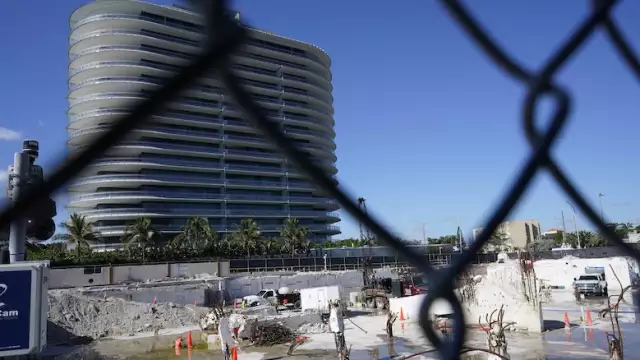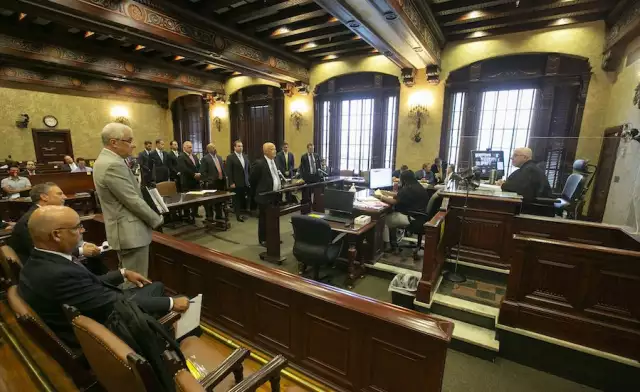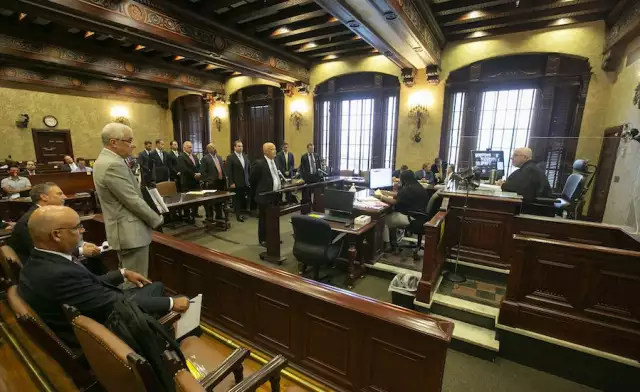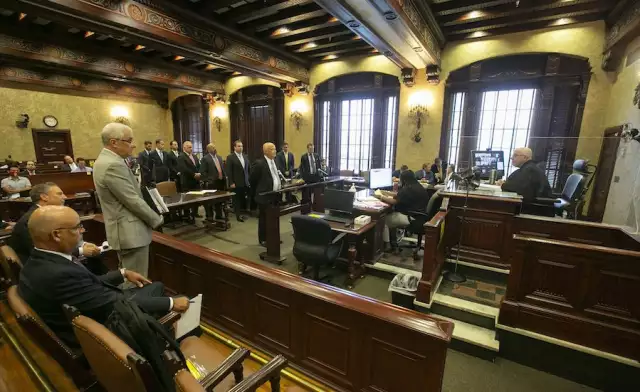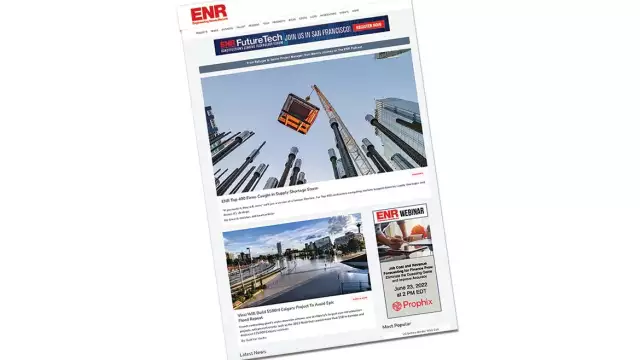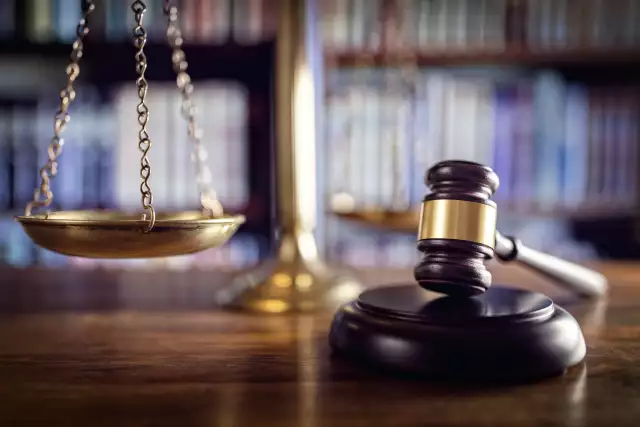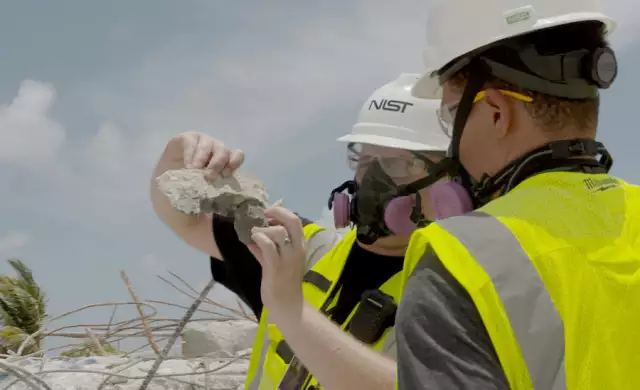Unproven Theory Opened Path to $997M Champlain Towers Collapse Settlement
Unproven Theory Opened Path to $997M Champlain Towers Collapse Settlement
May 17, 2022 Richard Korman KEYWORDS Champlain Towers / structural collapse Order Reprints No Comments .pullquote{ width: 250px; padding: 20px; } .pullquote a:link{ border-bottom: none; } .pullquote a:hover{ border-bottom: 1px solid #000000; } .pullquote a:visited{ border-bottom: none; } .pullquote h4{ font-family: ariel, helvetica, sans-serif; } .pqfloatleft{ float: left; margin: 0 15px 10px 0; border-right: 4px solid #d91920; text-align: right; } .pqfloatright{ float: right; margin: 0 0 10px 15px; border-left: 4px solid #d91920; } @media only screen and (max-width: 600px) { .pullquote{ margin: 20px auto 20px auto; width: 250px; display: block; } .pqfloatleft{ float: none; border-right: none; border-top: 2px solid #d91920; border-bottom: 2px solid #d91920; text-align: center; } .pqfloatright{ float: none; border-left: none; border-top: 2px solid #d91920; border-bottom: 2px solid #d91920; text-align: center; } } .cap { font-size: .85em; font-family: ariel, helvetica, sans-serif; text-align: center; margin-top: 0px; margin-bottom: 35px; color: #595959; } .line{ background-color: #d91218; height: 5px; margin-top: 5px; } .side ul{ padding-left: 20px; font-size: .85em; font-style: italic; margin: 10px 15px 10px 15px; } .side h3{ background-color: #135783; padding: 15px; color: #eeeeee; text-align: center; } .side h4{ color: #d91218; text-align: center; margin-top: 20px; } .side { color: #595959; width: 300px; display: inline-block; font-family: ariel, helvetica, sans-serif; } .side p { font-size: .85em; caption-side: bottom; padding: 10px 5px 0px 5px; } .floatleft{ float: left; margin: 0 15px 0px 0; } .floatright{ float: right; margin: 0 0 0px 15px; } @media only screen and (max-width: 600px) { .side{ margin: 20px auto 20px auto; width: 300px; display: block; } .floatleft{ float: none; } .floatright{ float: none; } } .sidebyside p { font-family: ariel, helvetica, sans-serif; font-size: .85em; caption-side: bottom; padding: 10px 5px 0px 5px; color: #808080; } .sidebyside{ width: 50%; float: left; display: block; display: inline-block; margin-bottom: 5px; padding-right: 5px; } .clearfloat{ clear: both; } @media only screen and (max-width: 600px) { .sidebyside{ width: 100%; float: none; display: block; } } .bigside{ background-color: #eaf1f7; padding: 20px; margin: 20px auto 20px auto; border: 1px solid silver; border-radius: 10px; }
The theory is mostly undebated and unproven. The money is real.
Insurers for companies that built the luxury tower next door to the Champlain Towers South condominium, whose partial collapse last June was one of the most deadly in history, are coughing up hundreds of millions of dollars in a tentative settlement of a class-action negligence lawsuit by the collapse victims' families and survivors.
The tentative settlement from the remaining defendants, announced in Miami-Dade Circuit Court May 12, is $997 million.
The plaintiffs' central claim since November—when a half dozen new defendants were targeted—is that vibratory sheet-pile installation for the foundations of the high-rise apartment built next door were the main contributing factor for the night-time partial collapse that happened two years later, on June 24, 2021, that killed 98 people.

Images from latest lawsuit version show the new building in early construction and the footpath along its property line (left) and a still image from the only video of the actual collapse, taken from a camera on the neighboring property.
As the tragedy's one-year anniversary approaches, the plaintiffs' main theory—the one that expanded the lawsuit to include the building constructed next door and the defendants who settled—remains a big question mark.
As recently as early May, the developer, architect of record and prime contractor of the building next door, 87 Collins Avenue, now known as Eighty Seven Park, were still fighting those accusations by the survivors and victim's families, according to court records.
Several engineers have postulated that a critical area in the investigation, the pool deck, pulled away from the perimeter wall between the properties and pulled down the front of Champlain Towers South’s larger wing.
But the argument made by the plaintiffs—that vibratory pile installation near the property line for the new building inflicted critical wounds on Champlain Towers South—struck two independent engineers as a no more than a question mark given the still far-from-complete data and complex investigations.
Dawn E. Lehman, a University of Washington professor of civil and environmental engineering who has modeled Champlain Towers South based on its design and made numerous presentations about the collapse's forensic engineering, has a more conservative take on the subject. She says that damage along that wall is uneven and raises questions. But that there just isn't enough information available to say what occurred.
Theories related to damage from pile installation would require input from a geotechnical engineer, she says, who would need to evaluate a soil profile. "I don’t have that," she says.
The argument made by the plaintiffs, that vibratory pile installation near the property line for the new building inflicted critical wounds on Champlain Towers South, struck two independent engineers as no more than a question mark given the still far-from-complete data and complex investigations.
Neither does Allyn Kilsheimer, the investigative engineer hired by the city of Surfside to complete its own inquiry. He agrees that much more investigating and testing needs to be done before he could offer an opinion about the neighboring property vibration theory. "I don't know a lot about soil," he told ENR, noting that he uses a prestigious geotechnical consultant to help him with that part of his company's investigations. Both Lehman and Kilsheimer say authoritative statements about what happened will take more time.
So far, Champlain Towers South's numerous potential defects include poor design and flawed concrete construction, water intrusion and corrosion and a lack of costly needed maintenance. Much attention has been devoted to the pool area, which is near the property border.
The collapse's trigger event has not been authoritatively pinpointed, nor all the contributing factors. And that knowledge vacuum has been filled with theories as investigations drag onward. The final report from the federal National Institute of Standards & Technology could take many more months.
Meanwhile, those who suffered heavy personal and economic losses have been largely uncompensated.
Seeking the deepest pockets and heavily insured defendants is nothing new in negligence and personal injury trials. But the shocking events, emotional toll and the critical perspective on the business of the built world of south Florida have elevated findings about Champlain Towers South above those of other catastrophes.
An investigation by the Washington Post published in July, soon after the tragedy, first raised the issue of possible damage from the project next door.
But it wasn't until late summer and early fall 2022 that the plaintiffs began issuing subpoenas to companies that worked on the neighboring structure, known as Eighty Seven Park.
A New Version of Lawsuit
On November 16, the plaintiffs issued a new lawsuit. Instead of focusing on lax attention to fixing defects by the condo association, it claimed that Champlain Towers South was an older building in need of routine repairs and maintenance but it was not until construction began next door that the building "became so badly damaged and destabilized as to be unsafe," the lawyers for the families and survivors wrote.
The Champlain Towers South pool deck adjoined the building’s south foundation wall, which abutted a beach access walkway that the defendants built.
Immediately beneath the pool deck, dozens of concrete columns supported the 120-space parking garage and pool deck.
"Tragically, construction at Eighty Seven Park irreversibly damaged key structural elements, including the pool deck and support columns. Once these elements failed, the tower was incapable of standing," the lawsuit claimed.
According to the new claims, after acquiring the public street separating the structures, the developer's construction team excavated "a mere ten feet" from Champlain Towers South's exterior foundation wall and support columns and drove 40-ft-long sheet piles.
When it came to choosing a method for installing the piles, the new lawsuit claims, the Eighty Seven Park construction team chose a less costly method that generated a higher level of vibrations than alternative methods. During the work the vibrations regularly exceeded a maximum goal the team had set for vibrations of .5 in./second, especially during a critical three-week period of the construction.
As residents next door complained about the disturbing vibrations and possible damage, the lawsuit claims, the contractors and subcontractors and developers forged ahead with the pile work.
As residents next door complained about disturbing vibrations and possible damage, the lawsuit claims, the contractors and subcontractors and developers forged ahead with the pile work.
As spring neared, Miami-Dade circuit state court Judge Michael Hanzman worked to keep trial plans from being pushed too far into 2023. And momentum for settlements increased. In February and early March, the insurer for the condominium association's consulting engineer, Morabito Consultants, who evaluated the building and recommended repairs, settled lawsuits against the firm for $16 million. The condo association's law firm settled claims against it at the same time for $31 million.
In a statement Morabito Consultants praised the settlement as wise while saying that its work on Champlain Towers South was consistent with industry standards.
At the same time, DeSimone Consulting Engineers, the structural engineer of record for Eighty Seven Park, agreed to settle for $8.55 million, according to court documents. One news account from CNN reported the settlement but failed to note that DeSimone was the engineer for the building next door.
The remaining Eighty Seven Park defendants continued to fight the lawsuits against them--and to deny any blame for what happened.
And the attorneys for the survivors and victims' families continued in a third amended complaint, filed March 10, to expand the list of defendants to include Stantec Architecture, the project's architect of record beginning in 2015. Renzo Piano was Eighty Seven Park's main conceptual designer.
Except for DeSimone Consulting engineers, which could not be reached for comment, there’s no confirmed way to know yet how much the key defendants from Eight Seven Park are contributing to the settlement, or exactly who is in it.
How the defendants feel about being associated with the devastating partial collapse is clear.
Stantec Architecture, in a filing made April 29th, denied that it was negligent or that "ordinary diligence" in the upkeep of Champlain Towers South could have saved the structure except for the damage from Eighty Seven Park.
John Moriarty & Associates of Florida, the project's prime contractor, denied in an April 14 response to the lawsuit that its work caused any damage or had any impact on the structural integrity of Champlain Towers South. It denied that sheet-pile installation with a vibratory hammer is "ultrahazardous or abnormally dangerous." And Moriarty clarified that there was only pile installation, not pile-driving with a hammer.
Michael Thomas, attorney for the 8701 Collins Development, the developer of Eighty Seven Park, did offer a statement on the settlement. He said, “0ur clients’ insurers" were making a "business decision" to settle "in order to resolve claims against them and avoid the time, expense and inconvenience of litigation."
"It is neither an admission of liability nor recognition of the validity of any of the plaintiffs’ claims," he added. "The design, development and construction of [Eighty Seven Park] in no way caused or contributed to the collapse of Champlain Towers South. Our clients categorically deny any allegation to the contrary."
